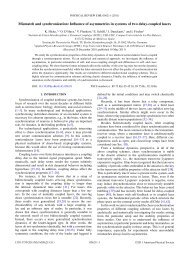DBI Analysis of Open String Bound States on Non-compact D-branes
DBI Analysis of Open String Bound States on Non-compact D-branes
DBI Analysis of Open String Bound States on Non-compact D-branes
You also want an ePaper? Increase the reach of your titles
YUMPU automatically turns print PDFs into web optimized ePapers that Google loves.
CHAPTER 3. SUPERSTRINGS 50miraculously c<strong>on</strong>firming our hopes that the NS and R sectors, after truncati<strong>on</strong>, do indeedgive rise to an equal number <str<strong>on</strong>g>of</str<strong>on</strong>g> space-time bos<strong>on</strong>s and fermi<strong>on</strong>s at each and every masslevel.Note that the match between both spectra does not prove space-time supersymmetry.But it is by any means a solid indicati<strong>on</strong>. Space-time supersymmetry can however beproven in the RNS formalism, but this is a highly n<strong>on</strong>-trivial endeavour.3.4.3 Closed stringsAs we already saw earlier, for closed strings we can combine R and NS c<strong>on</strong>diti<strong>on</strong>s infour distinct ways: (NS,NS), (NS,R), (R,NS) and (R,R). In order to obtain a space-timesupersymmetric spectrum though, we again need to perform the GSO projecti<strong>on</strong>. Forthe NS sector, this does not change much as far as our choices are c<strong>on</strong>cerned, howeverfor the R sector, this means we can choose between two chiralities, further increasingour number <str<strong>on</strong>g>of</str<strong>on</strong>g> possible choices.Essentially, this gives rise to two types <str<strong>on</strong>g>of</str<strong>on</strong>g> superstring theories: Type IIA and TypeIIB. Note that also in the superstring case, closed strings should satisfy the levelmatchingc<strong>on</strong>diti<strong>on</strong>, which still states that the left- and right-moving states shouldhave the same mass. From this we c<strong>on</strong>clude that the full spectrum <str<strong>on</strong>g>of</str<strong>on</strong>g> both theories isobtained by tensoring left- and right-moving states <str<strong>on</strong>g>of</str<strong>on</strong>g> equal mass level.Type IIAThe Type IIA theory is the <strong>on</strong>e that results when <strong>on</strong>e chooses opposite chiralities for theleft- and right-moving R sectors. They should be chosen opposite, but which is whichdoes not matter. The massless states <str<strong>on</strong>g>of</str<strong>on</strong>g> this theory are summarized in Table 3.1. Thechiralities are denoted by R and ¯R. Only massless states are shown because first <str<strong>on</strong>g>of</str<strong>on</strong>g> allwe will <strong>on</strong>ly be interested in those, and sec<strong>on</strong>d, the number <str<strong>on</strong>g>of</str<strong>on</strong>g> states at the first massivelevel is. . . massive.Looking at the massless states, our attenti<strong>on</strong> is grabbed by the (NS,NS) sector.Massless states in this sector are created by acting up<strong>on</strong> the vacuum state much in thesame way as for obtaining the massless bos<strong>on</strong>ic closed string states (cfr. Eq. 2.138).This again suggests a decompositi<strong>on</strong> in a tracless symmetric and antisymmetric part,and a part that is proporti<strong>on</strong>al to the unit matrix. In other words, we find back ourg µν , B µν and Φ fields!The (R,NS) and (NS,¯R) sectors give rise to two gravitinos with opposite chirality(<strong>on</strong>e for each sector), and two dilatinos, also with opposite chirality. The fact that twogravitinos are present indicates that space-time is N = 2 supersymmetric. 8The (R,¯R) sector gives rise to 64 massless states (8×8). These can be decomposed ina vector gauge field A µ and an antisymmetric three-form gauge field A µνρ . Notice thatA µ c<strong>on</strong>tains 8 states, and that A µνρ c<strong>on</strong>tains ( 83)= 56 states, the sum <str<strong>on</strong>g>of</str<strong>on</strong>g> which indeed8 This means that there are two supersymmetric transformati<strong>on</strong>s, and hence the doublets (X, ψ) getexpanded to quadruplets (X 1, X 2, ψ 1, ψ 2).
















